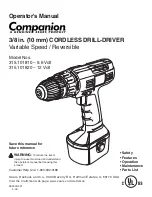
25
f) Specific safety instructions for circular saws
Safety instructions for all saws
• DANGER: Keep hands far from the cutting area and the saw blade. Keep the second hand on the
auxiliary hand grip, or on the motor case. If both hands are holding the saw, they cannot be cut by the
saw blade.
• Do not approach the lower part of the piece being processed. The guard cannot protect you from the saw
blade below the piece being processed. Your hands could get into the running saw blade protruding from
the workpiece and cause injury.
• Adjust the cutting depth to the thickness of the piece being processed. It is best to have less than one
whole tooth visible below the piece being processed.
• Never hold the piece to be cut in your hands or resting on your legs. Make sure the piece being pro-
cessed is on a stable platform. It is important for the piece being processed to be suitably fastened in
order to reduce the exposure of the body, the bending of the saw blade or loss of control to a minimum.
• While performing operations in which the cutting tool may come into contact with hidden cables, grip
power tools by the insulated grip surfaces. Contact with “live” cables will also “power” the exposed metal
parts of the tool and cause an electric shock to the operator.
• When sawing in the direction of the wood grain, use a stop collar or an edge guide. This makes the cut
more precise and reduces the possibility of the saw blade seizing.
• Always use saw blades with the correct size and location holes. Saw blades that do not correspond to the
saw assembly device will turn eccentrically, causing a loss of control.
• Never use damaged or unsuitable washers or bolts for fixing the saw blade. The washers and bolts of
the saw blade are expressly designed for the saw in question, in order to improve the performance and
operating safety.
• Before attaching or removing saw blades, the battery must be removed from the appliance. Any mainte-
nance must be performed safely in order to prevent accidents caused by an unexpected start.
• If the electrical tool slops during use, switch it off immediately. Do not force difficult operations for the
appliance.
• Collect the dust produced by connecting the electrical tool connection to a vacuum. This will provide the
best protection for your respiratory tracts and the job will be easier.
• The dust produced could be very flammable. Risk of fire! Regularly remove the dust produced from the
work area.
• Inhalation or contact with some types of wood is harmful to health. Always find out about the material you
are working on and adopt the necessary precautions.
• Using the electrical tool produces dust, noise and vibrations. Use personal protective equipment to pro-
tect your health.
• The saw base surface must always rest firmly on the workpiece when working.
• Sawing materials that contain asbestos may generate dust dangerous to your health. Comply with gov-
ernment regulations and manufacturer recommendations.
















































